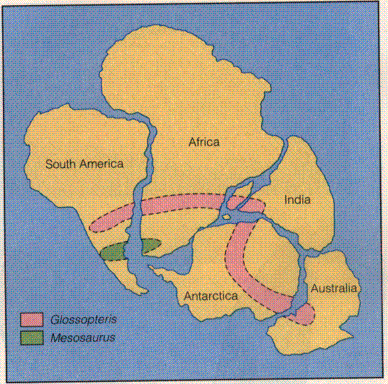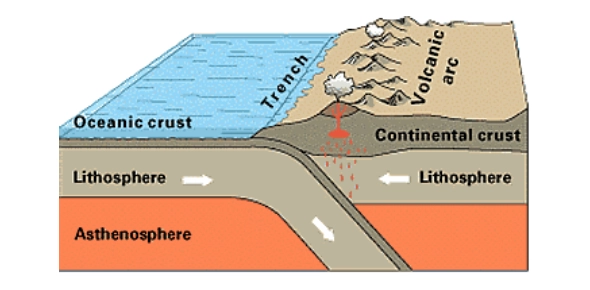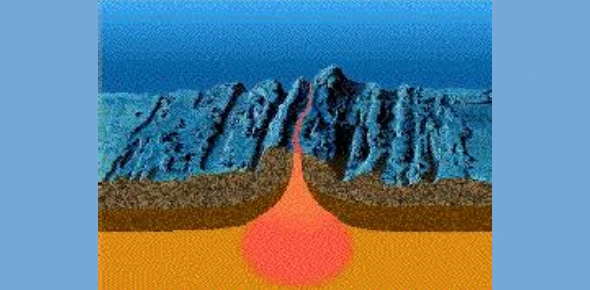Continental Drift Assessment 1-a, 2-a, 1-b, 2-b

This assessment will cover the concepts, essential questions and vocabulary studied in this unit.
- 1.
Choose the answer below that BEST describes this image
- A.
Mesosaurus lived in South America, India, Africa and Antarctica
- B.
Glossopteris appeared in the fossil records of the entire continent
- C.
Mesosaurus became extinct before the continent broke up.
- D.
Both Glossopteris and Mesosaurus are trace fossils.
Correct Answer
B. Glossopteris appeared in the fossil records of the entire continentExplanation
The correct answer is Glossopteris appeared in the fossil records of the entire continent. This answer is supported by the statement that Glossopteris appeared in the fossil records of the entire continent, indicating that it was found in multiple locations across the continent. The other statements provide information about the distribution and extinction of Mesosaurus, but they do not directly relate to the appearance of Glossopteris in the fossil records.Rate this question:
-
- 2.
Take a look at this Image. This is how Pangea MIGHT have looked 250 MYA. What is the continent called that contains North America and Eurasia
- A.
Gondwannaland
- B.
Laurasia
- C.
Thethys Sea
- D.
Equator
Correct Answer
B. LaurasiaExplanation
Laurasia is the correct answer because it is the name of the ancient supercontinent that consisted of North America and Eurasia. It is believed to have existed during the Mesozoic era, around 250 million years ago, when the continents were still connected as one landmass called Pangea. Laurasia eventually split into North America and Eurasia due to tectonic movements.Rate this question:
-
- 3.
T or F A Divergent Boundary is causing the Rift Valley To form.
- A.
True
- B.
False
Correct Answer
A. TrueExplanation
A divergent boundary is a type of tectonic plate boundary where two plates move away from each other. This movement causes the lithosphere to crack and create a rift valley. Therefore, it is true that a divergent boundary is causing the Rift Valley to form.Rate this question:
-
- 4.
Take a look at this image. Choose the BEST answer(s) that provide evidence for Alfred Wegner's CONTINENTAL DRIFT THEORY.
- A.
The continents fit together like a puzzle
- B.
Messosaurus fossils appear in South America and Africa in relatively the same area
- C.
The Tethys Sea was shallow and warm.
- D.
Glossopteris fossils were discovered in all areas of the supercontinent.
Correct Answer(s)
A. The continents fit together like a puzzle
B. Messosaurus fossils appear in South America and Africa in relatively the same area
D. Glossopteris fossils were discovered in all areas of the supercontinent.Explanation
The answer choices "the continents fit together like a puzzle," "Messosaurus fossils appear in South America and Africa in relatively the same area," and "Glossopteris fossils were discovered in all areas of the supercontinent" provide evidence for Alfred Wegner's Continental Drift Theory. The idea that the continents fit together like a puzzle supports the concept that they were once connected. The presence of the same fossils in South America and Africa suggests that these landmasses were once joined. The discovery of Glossopteris fossils in all areas of the supercontinent indicates that these regions were once part of a larger landmass.Rate this question:
-
- 5.
Who proposed the theory of continental drift?
- A.
Alfred Wegener
- B.
Alfred
- C.
Bob
- D.
Annie Wegener
Correct Answer
A. Alfred WegenerExplanation
Alfred Wegener is the correct answer because he proposed the theory of continental drift. This theory suggests that the continents were once joined together in a single landmass called Pangaea and have since drifted apart to their current positions. Wegener gathered evidence from various fields such as geology, paleontology, and climatology to support his theory, although it was initially met with skepticism. His work laid the foundation for our understanding of plate tectonics and the dynamic nature of the Earth's surface.Rate this question:
-
- 6.
How long did it take for the continents to make it to their current postions?
- A.
200 billion years
- B.
3000 million years
- C.
200 million years
Correct Answer
C. 200 million yearsExplanation
The correct answer is 200 million years. This is because the movement of continents, known as plate tectonics, is a slow process that occurs over millions of years. Through the process of continental drift, the continents have gradually moved and shifted to their current positions over a span of approximately 200 million years.Rate this question:
-
- 7.
What was the name of the super-continent?
- A.
Pangeo
- B.
Pang
- C.
Pangea
Correct Answer
C. PangeaExplanation
The correct answer is Pangea. Pangea was the name of the super-continent that existed millions of years ago. It was a landmass that included almost all of Earth's present-day continents. The name "Pangea" comes from the Greek words "pan" meaning "all" and "gea" meaning "earth." The super-continent began to break apart around 200 million years ago, leading to the formation of the continents we know today.Rate this question:
-
- 8.
What layer of the earth do tectonic plates occupy?
- A.
Lithosphere
- B.
Curst and Upper Mantle
- C.
Asthenosphere
Correct Answer
A. LithosphereExplanation
Tectonic plates occupy the layer of the earth known as the lithosphere. The lithosphere is the rigid outer layer of the earth, consisting of the crust and the uppermost part of the mantle. It is divided into several large and small tectonic plates that float on the semi-fluid asthenosphere below. These plates are constantly moving and interacting with each other, causing earthquakes, volcanic activity, and the formation of mountains and other geological features.Rate this question:
-
- 9.
How many types of plate boundaries are there?
- A.
2
- B.
3
- C.
2.5
- D.
4
Correct Answer
B. 3Explanation
There are three types of plate boundaries: convergent boundaries, where plates collide; divergent boundaries, where plates move apart; and transform boundaries, where plates slide past each other.Rate this question:
-
- 10.
What boundary were the Himalayas created?
- A.
Divergent
- B.
Convergent
- C.
Transform
Correct Answer
B. ConvergentExplanation
The Himalayas were created as a result of convergent boundaries. Convergent boundaries occur when two tectonic plates collide with each other. In the case of the Himalayas, the Indian Plate and the Eurasian Plate collided, causing the Indian Plate to be forced underneath the Eurasian Plate. This process, known as subduction, led to the formation of the Himalayan mountain range. The collision between these two plates continues to this day, causing the Himalayas to grow taller each year.Rate this question:
-
- 11.
If our exploration of other planets revealed that the planet MARS has "marsquakes" and infrequent emissions of gasses from volcanic eruptions, which of the following assumptions could scientists make? (Check all that apply)
- A.
Mars possibly has crustal plates that are in motion.
- B.
Mars has some type of convection activity beneath Mars' surface.
- C.
Mars has surface features such as mountains that have changed over time..
- D.
Mars has an inner core that is completely solid and immobile.
Correct Answer(s)
A. Mars possibly has crustal plates that are in motion.
B. Mars has some type of convection activity beneath Mars' surface.
C. Mars has surface features such as mountains that have changed over time..Explanation
Based on the information provided, scientists could make the assumption that Mars possibly has crustal plates that are in motion because marsquakes suggest tectonic activity. They could also assume that Mars has some type of convection activity beneath its surface because infrequent emissions of gasses from volcanic eruptions indicate the presence of molten material. Additionally, scientists could assume that Mars has surface features such as mountains that have changed over time because tectonic activity and volcanic eruptions can cause geological changes on a planet's surface.Rate this question:
-
- 12.
According to the following diagram, which of the below statements is true?
- A.
Substantial evidence exists that supports the Pangaea did exist and eventually broke up into drifting continents.
- B.
The break up of Pangaea is questionable.
- C.
Antarctica has always been in a southern position and very cold.
- D.
Glossopteris seeds can easily be dispersed over large masses of water.
Correct Answer
A. Substantial evidence exists that supports the Pangaea did exist and eventually broke up into drifting continents.Explanation
The diagram likely provides evidence or information that supports the existence of Pangaea and its eventual breakup into drifting continents.Rate this question:
-
- 13.
According to this diagram, which direction will the continent move?
- A.
Right
- B.
Left
- C.
The continent will NOT move
- D.
South
- E.
North
Correct Answer
B. LeftExplanation
Based on the given diagram, the continent will move to the left.Rate this question:
-
- 14.
Which of the following best describes this diagram?
- A.
Divergent plate boundary
- B.
Oceanic-Oceanic Convergence
- C.
Oceanic-Continental Convergence
- D.
Continental-Continental Convergence
- E.
Transform Fault
Correct Answer
C. Oceanic-Continental ConvergenceExplanation
The diagram most likely depicts an oceanic-continental convergence. This is indicated by the presence of an oceanic plate and a continental plate coming together. In this type of boundary, the denser oceanic plate subducts beneath the less dense continental plate, resulting in the formation of a trench and volcanic activity. This process often leads to the formation of mountain ranges and volcanoes on the continental side.Rate this question:
-
- 15.
The following diagram can best be described as?
- A.
A destructive mid-ocean ridge
- B.
A constructive mid-ocean ridge
- C.
A destructive trench
- D.
A constructive trench
Correct Answer
B. A constructive mid-ocean ridgeExplanation
The diagram can be described as a constructive mid-ocean ridge because it shows the formation of new oceanic crust as two tectonic plates move apart. This process, known as seafloor spreading, occurs at mid-ocean ridges where magma rises to the surface and solidifies, creating new crust. This leads to the expansion of the ocean basin and the formation of a ridge-like feature.Rate this question:
-
- 16.
With the history of Alfred Wegener and his research to promote the continental drift theory, which of the following statements accurately describes the nature of science?
- A.
Scientific ideas are not shared or discussed with others in the scientific community.
- B.
Scientific ideas are never met with skepticism.
- C.
Scientific ideas are subject to change with new evidence.
- D.
Scientific ideas are facts.
Correct Answer
C. Scientific ideas are subject to change with new evidence.Explanation
Scientific ideas are subject to change with new evidence because science is a process of continuous inquiry and discovery. As new evidence is collected and analyzed, it can either support or contradict existing scientific ideas. When evidence contradicts a previously accepted idea, scientists revise their understanding to accommodate the new information. This process allows for the advancement and refinement of scientific knowledge over time. It demonstrates the dynamic and self-correcting nature of science, where ideas are constantly being tested, evaluated, and modified based on new evidence.Rate this question:
-
- 17.
Based on the following diagram, which of the following is true?
- A.
Rocks near the ridge are 80 million years old.
- B.
Rocks near the coastlines are less than 10 million years old
- C.
Pangaea broke up approximately 180 million years ago.
- D.
Continents have taken less than 100 million years to drift to their current positions.
Correct Answer
C. Pangaea broke up approximately 180 million years ago.Explanation
The diagram suggests that Pangaea, the supercontinent that existed millions of years ago, broke up approximately 180 million years ago. This is supported by the fact that the rocks near the ridge, which were once part of Pangaea, are 80 million years old. Therefore, it can be concluded that the breakup of Pangaea occurred around 180 million years ago.Rate this question:
-
- 18.
Based on this diagram, which of the following conclusions can you make?
- A.
Rocks near the Mid Atlantic Ridge are old.
- B.
Rocks near the coastlines are young.
- C.
The Mid Atlantic Ridge separated at uniform rates throughout history.
- D.
Continents drifted away from the Mid Atlantic Ridge.
Correct Answer
D. Continents drifted away from the Mid Atlantic Ridge.Explanation
The diagram provided suggests that the continents have moved away from the Mid Atlantic Ridge over time. This conclusion can be drawn based on the observation that the rocks near the Mid Atlantic Ridge are older, indicating that they have been in place for a longer period of time. In contrast, the rocks near the coastlines are younger, suggesting that they have formed more recently as the continents have moved away from the ridge. This supports the conclusion that continents have drifted away from the Mid Atlantic Ridge.Rate this question:
-
- 19.
TRUE or FALSE Alfred Wegener's idea of continental drift was readily accepted upon first introduction.
- A.
TRUE
- B.
FALSE
Correct Answer
B. FALSEExplanation
Alfred Wegener's idea of continental drift was not readily accepted upon first introduction. Initially, his theory faced significant skepticism and criticism from the scientific community. Many geologists at the time believed in the concept of fixed continents and were resistant to the idea of continents drifting over time. It was only later, with the accumulation of more evidence and advancements in the understanding of plate tectonics, that Wegener's theory gained widespread acceptance.Rate this question:
-
- 20.
Which of the following is evidence that supports continental drift?
- A.
Mesosaurus fossils on South America and Africa
- B.
Dinosaur fossils from the Mesozoic era
- C.
Large sediment deposits on the ocean floor
- D.
Plant fossils found in upper Africa
Correct Answer
A. Mesosaurus fossils on South America and AfricaExplanation
The presence of Mesosaurus fossils on both South America and Africa provides evidence that supports continental drift. Mesosaurus was a freshwater reptile that could not have crossed the ocean, so the fact that its fossils are found on two separate continents suggests that these continents were once connected and have since drifted apart. This supports the theory of continental drift, which states that the Earth's continents were once joined together in a single landmass called Pangaea and have since moved to their current positions.Rate this question:
-
- 21.
Why can Polar Shift be the most catastrophic event for the earth?
Quiz Review Timeline +
Our quizzes are rigorously reviewed, monitored and continuously updated by our expert board to maintain accuracy, relevance, and timeliness.
-
Current Version
-
Sep 02, 2024Quiz Edited by
ProProfs Editorial Team -
Jan 11, 2012Quiz Created by
Rdteague
 Back to top
Back to top






.webp)



